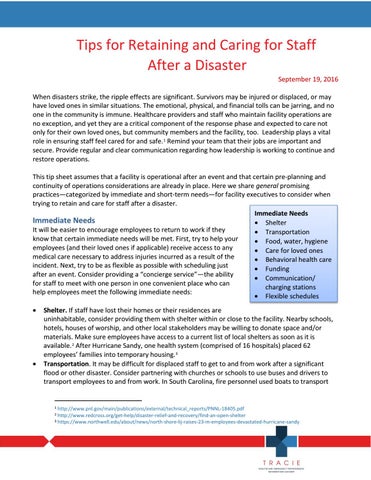Tips for Retaining and Caring for Staff
After a Disaster
September 19, 2016
When disasters strike, the ripple effects are significant. Survivors may be injured or displaced, or may have loved ones in similar situations. The emotional, physical, and financial tolls can be jarring, and no one in the community is immune. Healthcare providers and staff who maintain facility operations are no exception, and yet they are a critical component of the response phase and expected to care not only for their own loved ones, but community members and the facility, too. Leadership plays a vital role in ensuring staff feel cared for and safe. 1 Remind your team that their jobs are important and secure. Provide regular and clear communication regarding how leadership is working to continue and restore operations. This tip sheet assumes that a facility is operational after an event and that certain pre-planning and continuity of operations considerations are already in place. Here we share general promising practices—categorized by immediate and short-term needs—for facility executives to consider when trying to retain and care for staff after a disaster. Immediate Needs Immediate Needs • Shelter It will be easier to encourage employees to return to work if they • Transportation know that certain immediate needs will be met. First, try to help your • Food, water, hygiene employees (and their loved ones if applicable) receive access to any • Care for loved ones medical care necessary to address injuries incurred as a result of the • Behavioral health care incident. Next, try to be as flexible as possible with scheduling just • Funding after an event. Consider providing a “concierge service”—the ability • Communication/ for staff to meet with one person in one convenient place who can charging stations help employees meet the following immediate needs: • Flexible schedules • Shelter. If staff have lost their homes or their residences are uninhabitable, consider providing them with shelter within or close to the facility. Nearby schools, hotels, houses of worship, and other local stakeholders may be willing to donate space and/or materials. Make sure employees have access to a current list of local shelters as soon as it is available. 2 After Hurricane Sandy, one health system (comprised of 16 hospitals) placed 62 employees’ families into temporary housing. 3 • Transportation. It may be difficult for displaced staff to get to and from work after a significant flood or other disaster. Consider partnering with churches or schools to use buses and drivers to transport employees to and from work. In South Carolina, fire personnel used boats to transport
http://www.pnl.gov/main/publications/external/technical_reports/PNNL-18405.pdf
http://www.redcross.org/get-help/disaster-relief-and-recovery/find-an-open-shelter
3 https://www.northwell.edu/about/news/north-shore-lij-raises-23-m-employees-devastated-hurricane-sandy 1 2
